
This was made from a pattern in a Crochet magazine.

This one I kind of invented myself.

This was made from a pattern in a Crochet magazine.

This one I kind of invented myself.
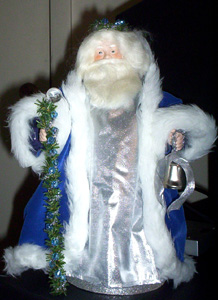
This Santa was made from a kit and was my first sewing project as an adult, getting me back into the fun of sewing. The head and hands were pre-made.

I got several nice books on decorating for Christmas at the post-Christmas sale at Border’s this year. They’re full of ideas for ornaments, one of which was to apply gold leafing (which comes in both real and fake varieties – this is the fake) to clear plastic balls in various designs. Two things about this:
1. Gold leafing is kind of hard to do on a ball. It might be better to learn the technique on something flatter and easier to handle.
2. Glass was wrong – plastic was right. The way that gold leafing goes on is you apply a glue first, wait for it to almost dry, then rub the gold leafing on to it. In order to get a good transfer you need to rub pretty hard. Well, luckily they must coat the insides of those glass balls with something to keep them from shattering so I didn’t actually sever my thumb, but I certainly did destroy the ball.
This pattern of random dots was my third and last attempt at applying gold leafing to glass balls. It was the only one I kept. One ball got broken just trying to remove it from the plastic tray it came in. So out of a box of 4 balls, luckily acquired very cheaply in another post-Christmas sale this time from Michael’s, I got one ornament. I do have plenty of gold leafing left though and perhaps I’ll give it another try some day on a surface either flatter or less fragile.
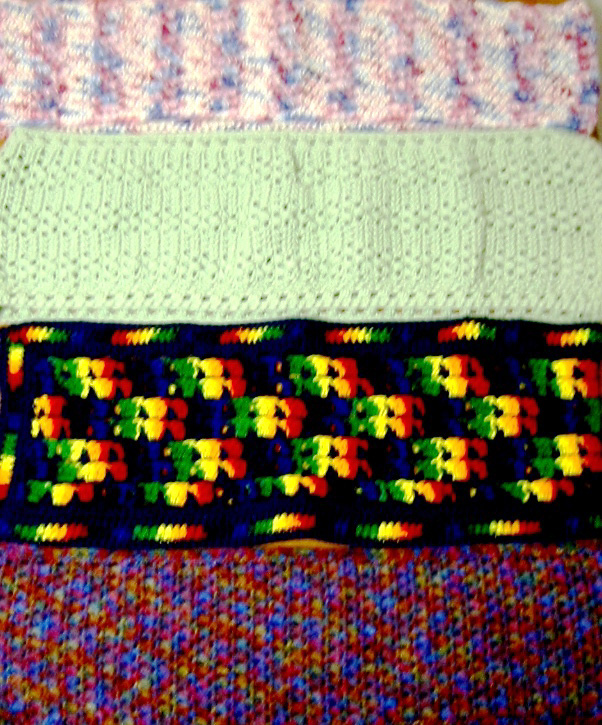
These scarves were made with the first four patterns in the booklet Special Stitches Scarves (not necessarily in that order). I’m especially fond of the bottom one. It’s a very pretty pattern and I love the yarn which is left over from an afghan I made for my boyfriend.

Here’s a close-up of the top scarf. A woman I met on the internet sent this wool to me when I told her about how my Grandmother and I knit and crochet hats and scarves for charity. The wool was hand spun and hand-dyed from goats raised on her farm.

I used to have a freebie blanket in a blue/green/white tartan plaid from Microsoft. I liked the colors but it said “Microsoft” in one corner and it had gotten grungy and had a cigarette burn hole in it. When I quit smoking I decided to toss it and make myself a new blanket. This crochet pattern came from A Year of Afghans Book 5 which I’ve gotten several afghans out of. It’s the pattern called “Windowpane Wrap.” The pattern called for a very different color scheme with white as the dominant color and a series of pastels alternating for the underlying colors. I changed it to match my old blue/green/white scheme and am very happy with the result.
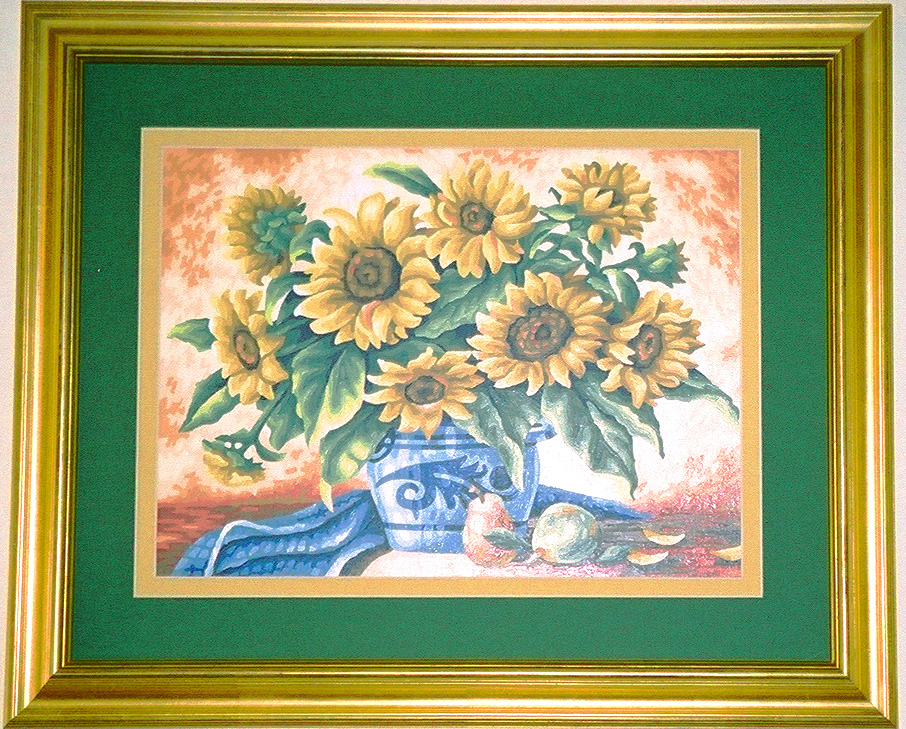
I’d never done a paint-by-numbers kit before. They’re a lot of work – those areas are pretty small and there are a lot of them. I was really happy with the result though, especially with the mats and frame which I got from Frames by Mail. I got the kit from Herrschners. They have a wide variety of kits, not just cutesy kittens and frolicking dolphins.
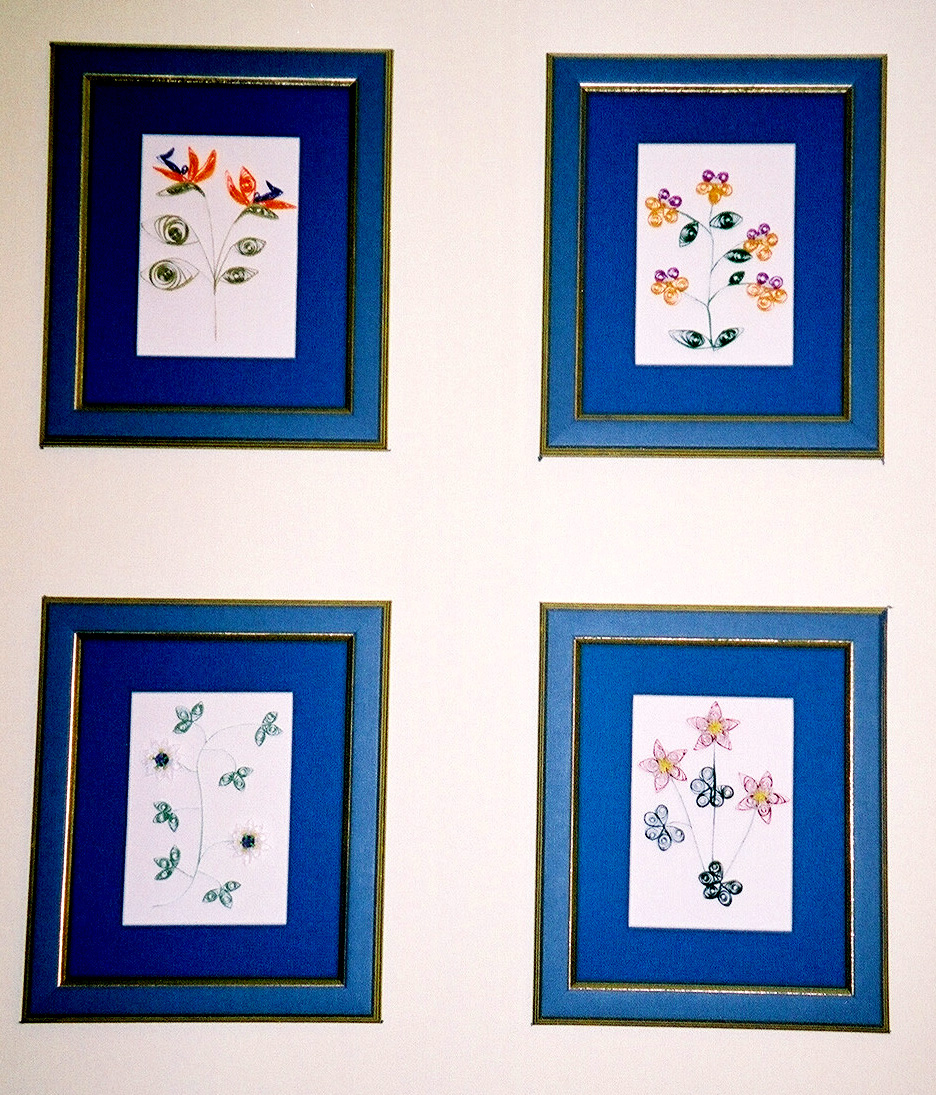
I made a series of four flowers from A Guide to Quilling Flowers and framed them in beautiful blue frabric frames from A. C. Moore. Although you can’t see the detail in these photos, the paper the flowers are mounted on is very pretty also – a sort of cream pinstripe. The current enthusiasm for scrap-booking means there are many interesting card stocks to choose from these days.
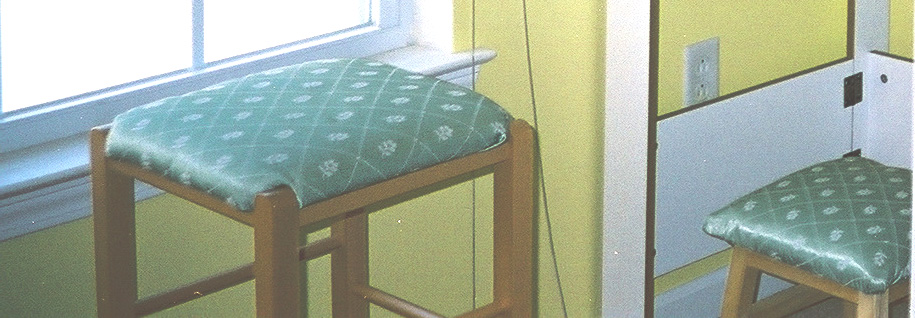
These stools (sitting stool and foot stool) were purchased at Target. They had hard wood tops. I covered them in batting and fabric from curtains I got at a tag sale for $1. I used the Trading Spaces method: fold and staple. The stools make sitting at my standing height craft/cutting table comfortable.
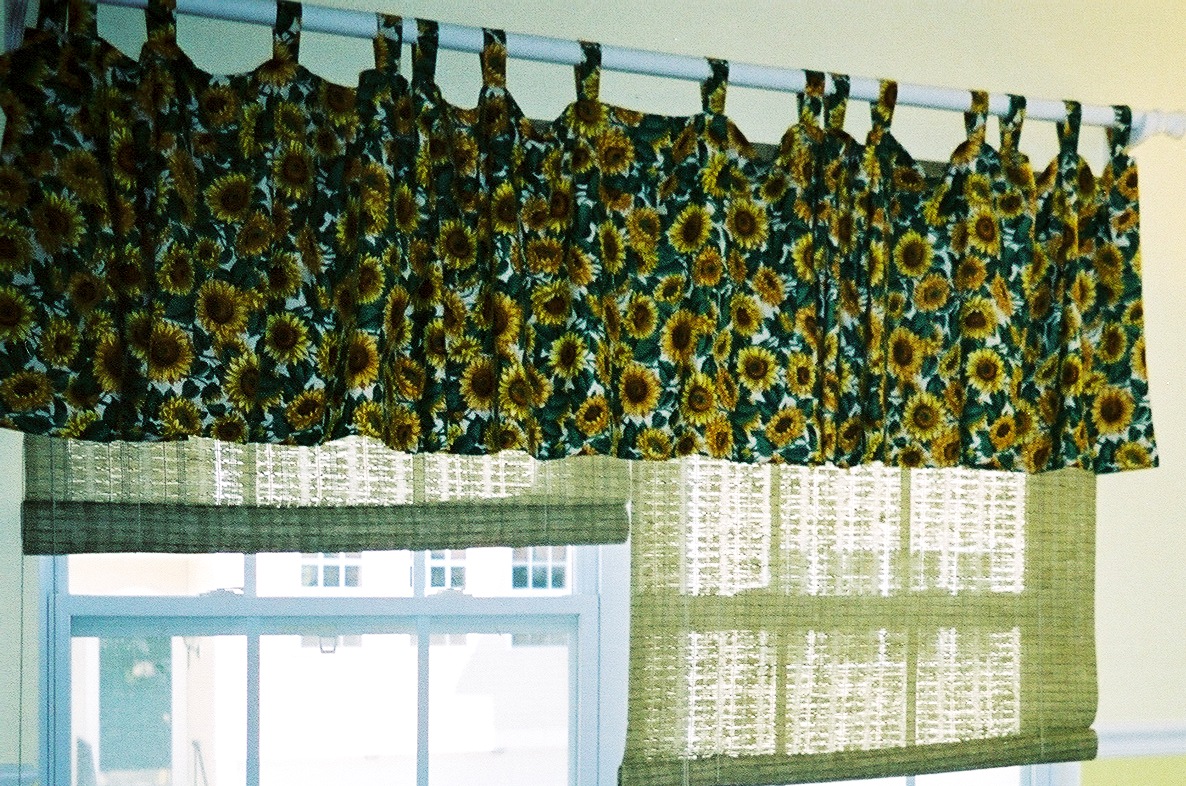
I made the pictured valance without a pattern from cheapy Wal-Mart fabric by simply folding the fabric in half, right sides together, and sewing along the sides. Then I made the tabs – what a pain to turn them all – pinned them inside the unsewn top and top-stitched. If I had it to do again, I’d probably make the valance shorter. The fabric shades came from Pier One.
I taught myself to crochet in January of 2001. I’d been climbing for about a year and a half by then and I decided to take the month off to give my body and my mind a rest. I was looking for a craft I could enjoy doing, as opposed to counted cross stitch which I enjoyed the results of but pretty much hated the process for.
Learning to crochet wasn’t bad at all. Of course I was slow at first and my tension was all over the place so I never knew what gauge I was working to. Indeed, it sometimes changed mid-project as mentioned previously. But it didn’t take long before I was good enough to enjoy it, at which point Todd suddenly decided he was going to learn to crochet too. I couldn’t teach him because I’m left handed and he’s right but he taught himself from the same books I used and got pretty good pretty fast and decided he wanted to make himself an afghan.
I tried to tell him that an afghan was a pretty big project and maybe he should start with something else but he’s an all or nothing kind of guy, so we went down to A. C. Moore to pick out a pattern and some yarn. Well, I talked him into this afghan made out of separate squares each made from a different stitch: 63 Easy-To-Crochet Pattern Stitches. I thought it would be fun to learn the different stitches and I could help him with it – we’d each do some squares and later combine them. I got the sequel – 63 More Easy-To-Crochet Pattern Stitches and we would each pick and choose which squares we wanted to make within certain guidelines. He didn’t want lacey ones – he liked the denser squares better. And of course we couldn’t do any particularly complicated ones, which there were plenty of despite the word “Easy” figuring prominently in the name.
It was a disaster. Each square was supposed to be the same size. 8″ I think. Take two novices and a bunch of different stitches and what do you think you end up with? We had everything from 6″ to 10″. They were never going to combine into an afghan.
So we gave up/lost interest. We did maybe 20 squares altogether. I finally threw them out not too long ago but before I did I picked out three of my favorites (that were relatively the same size) and framed them. They make kind of a cute craftsy type wall display.

The time wasn’t completely wasted. Aside from the wall display, I did learn how to do some pretty complicated stitches and I was forced to think harder about working to gauge. So I really think those squares are the basis for my ability to crochet today.
Having given up on the afghan, Todd decided to make himself a scarf (perhaps he should have started with the scarf, eh?). He picked out the yarn and chose to use a straightforward single crochet stitch. He did a few rows (the long way), then put it down one day and has never picked up a crochet hook since. A couple years later I finished it for him as a birthday present, carefully matching his gauge which I was an experienced enough crafter to do by then. He picked some nice yarn, didn’t he? It’s Lion Brand Wool-Ease Heather.

And that’s the story of Crocheting with Todd.